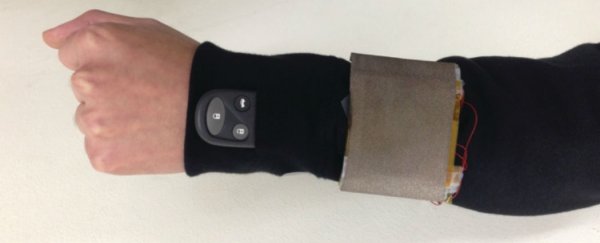Researchers in South Korea have invented a fabric patch that can be worn around your arm, and it can harvest enough energy from your regular arm moments to charge a small electronic device, such as a smartphone.
The charging fabric works using what's known as the triboelectric effect, which the principle behind static electricity. It's also known as contact electrification, which means you can render certain types of materials electrically charged by rubbing them against another type of surface. If you get the right combination of materials, just a small amount of fiction is all that's needed to convert mechanical energy into usable electricity.
The triboelectric effect works when you rub materials together and they form a chemical bond known as adhesion. Thanks to this bond, electrons are freely transferred from one material to the other, creating a build-up of positive charge in one, and a negative charge in the other. When the bond between the two materials is broken, an electric voltage is generated.
With this in mind, a team led by materials scientist Sang-Woo Kim from Sungkyunkwan University have invented a double-layer fabric made from woven fibres with one layer coated in silver and the other layer coated in minuscule zinc oxide nanorods that have been dipped in polydimethylsiloxane.
As Prachi Patel explains at Chemical & Engineering News, these nanorods help to increase the contact surface area between the two layers, which means a better output of friction, and more voltage. "When the researchers compressed a 4-cm by 4-cm patch of the two-layer textile with a 98-Newton force and then released it, the fabric generated 120 V and a 65-µamp current," says Patel. "To increase the power output, the team stacked four triboelectric generators to make a device that put out 170 V and 120 µamp. The device is mechanically strong, and it maintained this output for more than 12,000 compression cycles,"
The fabric, which the team has called a wearable triboelectric nanogenerator (WTNG), was then woven into a jacket sleeve, along with six LED lights, a small liquid crystal display, and a remote control car key. When the team asked a volunteer to put it on, all he had to do was move his arm and/or wrist to generate enough charge to power up each of those small devices, one at a time, without any help from external power sources.
This "proves potential applications of WTNGs in self-powered smart clothes, health care monitoring and self-powered wearable devices, and even personal electronics", the team concludes in the journal ACS Nano.
The technology is cheap to use and make, and will probably be more feasible than embedding solar cells into our clothes for the sam effect, says Patel at Chemical & Engineering News. Of course, no one's going to use it if it doesn't look great, so that's the next challenge researchers are going to have to overcome.
Source: Chemical & Engineering News
